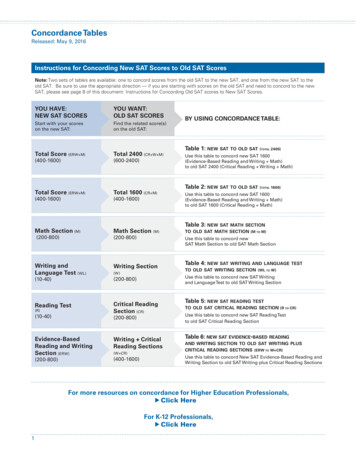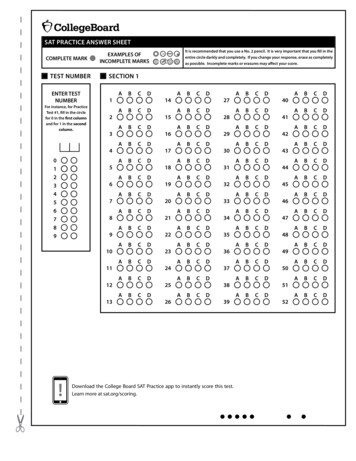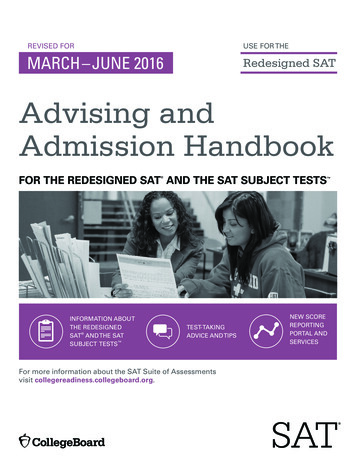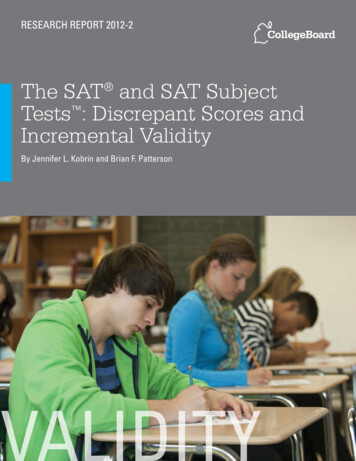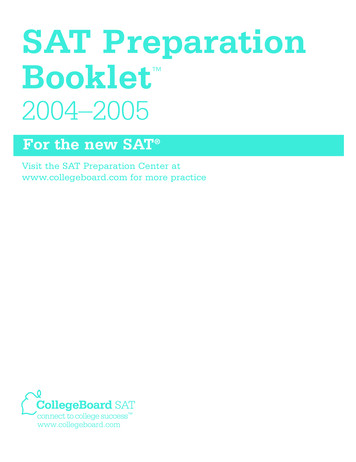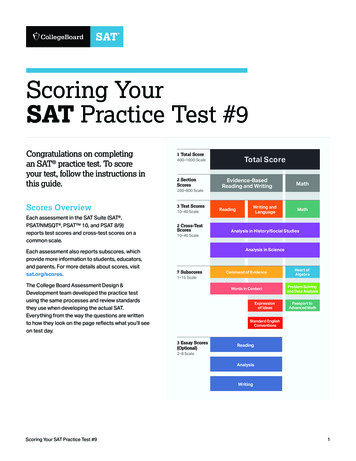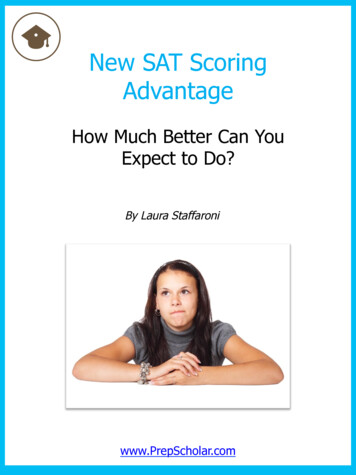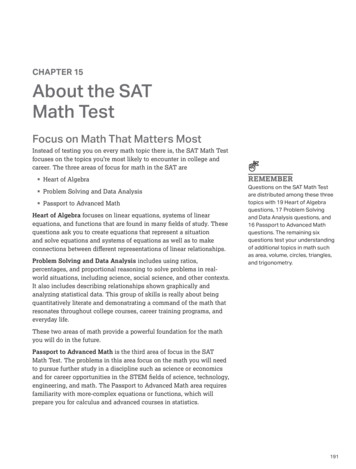
Transcription
CHAPTER 15About the SATMath TestFocus on Math That Matters MostInstead of testing you on every math topic there is, the SAT Math Testfocuses on the topics you’re most likely to encounter in college andcareer. The three areas of focus for math in the SAT are§ Heart of Algebra§ Problem Solving and Data Analysis§ Passport to Advanced MathHeart of Algebra focuses on linear equations, systems of linearequations, and functions that are found in many fields of study. Thesequestions ask you to create equations that represent a situationand solve equations and systems of equations as well as to makeconnections between different representations of linear relationships.Problem Solving and Data Analysis includes using ratios,percentages, and proportional reasoning to solve problems in realworld situations, including science, social science, and other contexts.It also includes describing relationships shown graphically andanalyzing statistical data. This group of skills is really about beingquantitatively literate and demonstrating a command of the math thatresonates throughout college courses, career training programs, andeveryday life.REMEMBERQuestions on the SAT Math Testare distributed among these threetopics with 19 Heart of Algebraquestions, 17 Problem Solvingand Data Analysis questions, and16 Passport to Advanced Mathquestions. The remaining sixquestions test your understandingof additional topics in math suchas area, volume, circles, triangles,and trigonometry.These two areas of math provide a powerful foundation for the mathyou will do in the future.Passport to Advanced Math is the third area of focus in the SATMath Test. The problems in this area focus on the math you will needto pursue further study in a discipline such as science or economicsand for career opportunities in the STEM fields of science, technology,engineering, and math. The Passport to Advanced Math area requiresfamiliarity with more-complex equations or functions, which willprepare you for calculus and advanced courses in statistics.191
PART 3 MathREMEMBERThe SAT Math Test requires astronger and deeper understandingof a relatively small number of mathtopics that are especially relevant incollege and in many careers.The SAT Math Test also contains questions in Additional Topicsin Math. Some of these problems focus on key concepts fromgeometry, including applications of volume, area, surface area,and coordinate geometry; similarity, which is another instance ofproportional reasoning; and properties of lines, angles, triangles andother polygons, and circles. There are also problems that focus onthe fundamental ideas of trigonometry and radian measure, whichare essential for study in STEM fields. Finally, there are problemsinvolving the arithmetic of complex numbers, another concept neededfor more-advanced study in math and the STEM fields.What the Math Test AssessesThe SAT Math Test assesses your understanding of mathematicalconcepts, your procedural skill and fluency in math, and your ability toapply those concepts and skills to real-world problems.Conceptual understanding and procedural skill and fluency arecomplementary. Together, they lead to a thorough understanding ofmathematical ideas and methods for solving problems. Questionson the SAT Math Test assess these skills in various ways becausethe ability to use mathematical ideas and methods flexibly shows anunderstanding of math that can be applied to a wide variety of settings.PRACTICE ATsatpractice.orgAs is mentioned throughout thisguide, the best preparation for theSAT is to work hard in your highschool classes. Applying your mathskills in your science and socialstudies classes will prepare you formany of the questions you’ll comeacross on the SAT Math Test.192A key to the relationship between fluency and conceptualunderstanding is recognizing and making use of structure. Recognizingstructure allows you to understand mathematical relationships in acoherent manner and making use of it allows you both to apply theserelationships more widely and to extend these relationships in usefulways. Many of the examples and sample questions in the followingchapters are more simply and deeply understood (and more quicklysolved!) if you observe structure in the mathematics of the problem.Problems Grounded inReal-World ContextsThe SAT Math Test features multistep problems with applications inscience, social science, career scenarios, and other real-life contexts.In some cases, you will be presented with a scenario and then askedseveral questions related to the same context. You learn specific mathskills in your math classes, and these skills are applied in your scienceand social studies classes. When you use your mathematical skillsoutside of the math classroom, you are preparing for the SAT.
Chapter 15 About the SAT Math TestThe Makeup of the SAT Math TestCalculator and No-Calculator PortionsThere are calculator and no-calculator portions on the SAT MathTest. A calculator is a tool, and the ability to determine when to useit is a skill that you’re expected to have. In the calculator portion,many questions don’t require a calculator and many questions can becompleted faster without using a calculator. In general, the questionsin the calculator portion are more complex than those in the nocalculator portion. Questions in the no-calculator portion emphasizeyour ability to do problems efficiently and accurately.You should bring a calculator to use on the calculator portion of theSAT Math Test. A scientific or graphing calculator is recommended,and familiarity with your calculator may provide an advantage onsome questions. Every question on the SAT can be solved without acalculator; however, strategically deciding when to use a calculatorwill reduce the time required to complete the test. Using a calculatorcan also help you avoid missing a question because of computationerrors.Multiple-Choice and Gridded-Response QuestionsREMEMBERYou’re permitted to use a calculatoron one portion of the SAT MathTest, so be sure to bring a calculatorwith you to the test. However, manyquestions don’t require a calculatorand can actually be solved morequickly without one, so use carefuljudgment in deciding when to use it.PRACTICE ATsatpractice.orgMake sure that you’re very familiarwith and comfortable using thecalculator you bring with you on testday. Practice using the calculatoryou’ll use on the test throughoutyour test preparation.About 80% of the questions on the Math Test are multiple-choice.Each multiple-choice question consists of a question followed by fouroptions. There is only one correct answer and there is no penalty forselecting an incorrect answer. Therefore, you should provide an answerto every question on the test.The other questions on the Math Test are gridded-response questions(also called student-produced response questions), and these questionsmake up about 20% of the test. The answer to each gridded-responsequestion is a number (fraction, decimal, or positive integer) that you’llenter on the answer sheet into a grid like the one shown on the nextpage. Like all questions on the SAT, there is no penalty for answeringa gridded-response question incorrectly.Examples of filled-in answer grids are shown on the next page. Notethat in addition to whole numbers, you may also enter a fraction lineor a decimal point. Further details on how to grid your answers areprovided in Chapter 21.PRACTICE ATsatpractice.orgThere is no penalty for selectingan incorrect answer on the SAT, sonever leave a question blank! Onquestions that you’re not sure howto solve, eliminate as many answerchoices as you can, and then guessfrom among the remaining choices.193
PART 3 Math7Answer: 12Writeanswerin boxes.REMEMBEROn gridded-response questions,you must fill in the bubbles thatcorrespond to your answer. Youwon’t receive credit if you write youranswer only in the boxes at the topof the grid.Make sure to get lots of practiceusing the facts and formulasprovided in the Reference section inthe Math Test directions. Practicingwith these facts and formulas willensure you can use them accuratelyand efficiently.Fractionlinehwb1A bh2A wrwV rr 2hh2xcbac 2 a2 b 2r4V rr 3360 xs 45 s 230 45 sx 3Special Right TriangleshhrThe number of degrees of arc in a circle is 360.The number of radians of arc in a circle is 2r.The sum of the measures in degrees of the angles of a triangle is 180.194DecimalpointThe Math Test includes the reference information shown below. Youmay find these facts and formulas helpful as you answer some of thetest questions, but make sure you have plenty of practice with thisinformation beforehand. To do well, you’ll need to be comfortableworking with these facts and formulas.rV wh2 . 5Mathematics Reference Informationsatpractice.orgh7 / 12Grid inresult.PRACTICE ATA rr 2C 2rrAnswer: 2.51V rr 2h3wV 1 wh3
Chapter 15 About the SAT Math TestTest SummaryThe following table summarizes the key content dimensions of the SATMath Test.SAT Math Test Content SpecificationsTime Allotted80 minutesCalculator Portion (38 questions)55 minutesNo-Calculator Portion (20 questions)25 minutesNumberPercentage of Test58 questions100%Multiple-Choice (MC, 4 options)45 questions78%Student-Produced Response(SPR—grid-in)13 questions22%19 questions33%17 questions29%16 questions28%Total QuestionsPRACTICE ATsatpractice.orgTake plenty of time to familiarizeyourself with this table. Knowingexactly what the Math Testconsists of, including the numberof questions and time allotted aswell as the distribution of questioncategories, will help you to feelconfident and prepared on test day.Contribution of Questions to SubscoresHeart of AlgebraAnalyzing and fluently solving linearequations and systems of linear equationsCreating linear equations and inequalitiesto represent relationships betweenquantities and to solve problemsUnderstanding and using the relationshipbetween linear equations and inequalitiesand their graphs to solve problemsProblem Solving and Data AnalysisCreating and analyzing relationshipsusing ratios, proportional relationships,percentages, and unitsRepresenting and analyzingquantitative dataFinding and applyingprobabilities in contextPassport to Advanced MathIdentifying and creating equivalentalgebraic expressionsCreating, analyzing, and fluently solvingquadratic and other nonlinear equationsCreating, using, and graphing exponential,quadratic, and other nonlinear functions195
PART 3 MathAdditional Topics in Math*PRACTICE ATsatpractice.orgAs you progress through yourtest practice, assess which mathskills you’re strongest in and whichyou have the greatest room forimprovement in. Allocate your studytime appropriately and make useof the many resources available toyou on the Khan Academy website(satpractice.org).6 questions10%Solving problems relatedto area and volumeApplying definitions and theorems relatedto lines, angles, triangles, and circlesWorking with right triangles, the unitcircle, and trigonometric functionsContribution of Questions to Cross-Test ScoresAnalysis in Science8 questions14%Analysis in History/Social Studies8 questions14%*Questions under Additional Topics in Math contribute to the total Math Test score butdo not contribute to a subscore within the Math Test.As indicated in the content specifications previously, the Math Testhas two portions. One is a 55-minute portion—38 questions forwhich you are permitted to use a calculator. The other is a 25-minuteportion—20 questions for which you are not permitted to use acalculator. The blueprint for each portion is shown below.Calculator PortionNumber of QuestionsTotal Questions38100%Multiple-Choice (MC)3079% Student-ProducedResponse (SPR—grid-in)821%Content Categories38100%Heart of Algebra1129%Problem Solving andData Analysis1745%Passport to Advanced Math718%Additional Topics in Math3Time Allocated196% of Test55 minutes
Chapter 15 About the SAT Math TestNo-Calculator PortionNumber of Questions% of Test20100%Multiple-Choice (MC)1575% Student-ProducedResponse (SPR—grid-in)525%Content Categories20100%Heart of Algebra840%Passport to Advanced Math945%315%Total Questions Additional Topics in MathTime AllocatedREMEMBERDon’t be intimidated by the fact thatyou can’t use a calculator on one ofthe SAT Math portions. Questionsin the no-calculator portion aremore conceptual in nature and don’trequire a calculator to be solved.25 minutes197
THIS PAGE IS INTENTIONALLY LEFT BLANK.
The SAT Math Test requires a stronger and deeper understanding of a relatively small number of math topics that are especially relevant in college and in many careers. What the Math Test Assesses. The SAT Math Test assesses your understanding of mathematical concepts, your procedural skill and fluency in math, and your ability to



